This is a Fujifilm GA645Wi Professional, an advanced medium format point and shoot camera made in Japan by Fuji starting in 1997. The GA645Wi was an updated version of the original GS645W, first introduced in 1983, featuring a 45mm wide angle lens, but adding almost every modern convenience such as auto focus, auto exposure, auto film loading, a viewfinder that automatically corrects for parallax, and an automatic flash. Like all cameras in Fuji’s 645 series, the GS645Wi shoots 4.5cm x 6cm images on 120 or 220 roll film. Despite having the word “Professional” in its name, this was a simple and easy to use camera that required no knowledge of photography to use.
Film Type: 120 or 220 Roll Film (16 or 32 4.5cm x 6cm [actual size 41.5mm x 56mm] exposures per roll)
Lens: 45mm f/4 Super-EBC Fujinon coated 7-elements in 5-groups
Focus: 0.7 meters to Infinity with Hybrid Auto Focus with Manual Override
Viewfinder: Illuminated Brightline Finder with Automatic Parallax Correction, 93% Field of View, 0.5x Magnification
Shutter: Electronic Leaf
Speeds: B, 2 – 1/700 seconds (Limited to 1/400 at f/4 – f/9.5)
Exposure Meter: Silicon Photo Diode Meter with Aperture Priority and Programmed Auto Exposure
Battery: (2x) 3v CR123A Lithium Battery
Flash Mount: Hot Shoe and Built in Pop Up Flash,
Other Features: Date Back, Self-Timer, Manual Focus, Focus Lock, Automatic Film Load, 220 Support
Weight: 880 grams
Manual: https://www.cameramanuals.org/fuji_pdf/fujifilm_ga645i.pdf
How these ratings work |
The Fujifilm GA645Wi Professional is a curious combination of old vs new. A medium format roll film camera that shoots 4.5cm x 6cm images on 120 and 220 film in a fully automatic everything point and shoot body, but with professional features like manual focus, full manual exposure, a date back, and an automatic parallax correcting viewfinder, this camera has something for everyone. The wide angle lens gets a lot in the frame and combined with the excellent optics of the Super-EBC Fujinon, it makes images unlike that of most other folding cameras. The Fujifilm GA645Wi Professional is not a cheap camera to buy, but for those who can afford it, gives the best of both worlds of roll film quality with modern features. | ||||||
| Images | Handling | Features | Viewfinder | Feel & Beauty | History | Age | |
| 2 | 2 | 1 | 2 | 1 | 1 | 0% | |
| Bonus | none | ||||||
| Final Score | 9.0 | ||||||
History
As I write this in January 2023, Fujifilm is the largest producer of both photographic film and film cameras in the world. Whaaaaat did I just say?
 Yep, our beloved Fuji, whose history dates back more than 100 years, and maker of some of the finest 35mm and medium format cameras ever made, is still the top dog of the film world. If you’re reading that and scratching your head because you can barely find Fuji 200 film on store shelves and you can’t remember a Fuji film camera worth a damn being made in several decades, you must be thinking I’m crazy.
Yep, our beloved Fuji, whose history dates back more than 100 years, and maker of some of the finest 35mm and medium format cameras ever made, is still the top dog of the film world. If you’re reading that and scratching your head because you can barely find Fuji 200 film on store shelves and you can’t remember a Fuji film camera worth a damn being made in several decades, you must be thinking I’m crazy.
Well, I’m not crazy, as Fuji’s Instax film and Instax film cameras are the best selling cameras in the world, film or digital (excluding smartphones). As recently as 2019, Fuji sold over 10 million Instax cameras and Fuji’s film business was bigger than every other manufacturer in the world…combined!
Of course, this isn’t a review about Instax or Instax film, so where am I going with this. If you look through the history of the photographic film industry, there are film companies and there are camera companies. No one company can be both at the same time. Eastman Kodak, maker of probably thousands of different cameras from the 1888 Kodak all the way to whatever their last camera was, was a film first company. Whenever they made a camera, it was with the intent of creating more customers to buy their film.
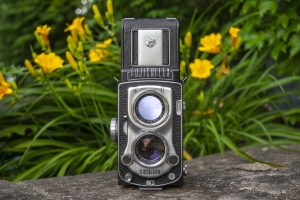
Fuji, although largely taking a similar path, seemed to randomly jump in and out of whatever market they pleased, with nary a notice. The company’s Fujica Six from 1948 was one of the first Japanese cameras to be made after World War II, the Fujicaflex Automat from 1954 was a top of the line and innovative 6×6 twin lens reflex that seemingly was designed to go head to head with the German Rolleiflex, the Fujica 35 Automagic from 1961 was an early iteration of a point and shoot 35mm camera with auto exposure. The company made cheap cameras, they made expensive cameras, they made wind up cameras, panoramic cameras, half frame cameras, and even twin lens point and shoots. They made rangefinders, 35mm SLRs with both leaf shutters and focal plane shutters, they made other SLRs with the M42 screw mount and some with their own bayonet lens mounts. They made 110 cameras, Disc film cameras, APS cameras, and yes, even instant film cameras. As I sit here now, I cannot think of a format or style of camera that Fuji didn’t make at least at one time.
Unlike Kodak however, who barring a few examples like the Ektra and Medalist, was content with making inexpensive cameras just good enough to make the most of Kodak film, but without costing an arm and a leg. In the mid 1950s, three and four element Kodak snapshot cameras with four speed rotary shutters were just good enough to make nice looking Kodachrome slides to show off vacation pics, but no self respecting professional photographer would be caught dead with one.
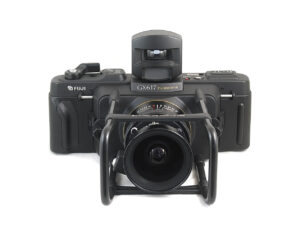
Fuji on the other hand, had no qualms playing in the professional market. The company’s successful lineup of 6×7, 6×8, 6×9, and even 6×17 cameras starting with the “Texas Leica” were immensely popular and continued to be produced well into the 21st century.
Somewhere along their confusing lineage of professional to semi-professional roll film cameras was their 645 models, or more specifically, roll film cameras that shot 4.5cm x 6cm images on 120 and sometimes 220 roll film. While I generally pride myself in my thorough historical research into cameras I’ve written about for this site, putting together a complete history of Fuji’s extremely confusing lineup of similarly named, but often very different models was more than I was willing to tackle.

For the 645 series cameras, we have to go back to March 1983 when Fuji announced their all new folding roll film rangefinder Fuji GS645 Professional at the 1983 PMA in Las Vegas. For many, the announcement came out of left field as “new” and “folding camera” hadn’t been uttered in the same sentence in quite some time. Although boasting modern features like a Gallium Photo Diode exposure meter with match LED display in the viewfinder, combined coincident image rangefinder with automatic parallax correction, and a modern 75mm f/3.4 coated lens.
I wasn’t there at the time, but from what little I’ve read in announcements from that PMA ’83 show, people were certainly interested. Not only had a folding bellows camera with professional level features not been released in many years, but the inclusion of modern features made it a compelling buy.
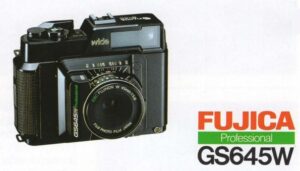
Fuji wasn’t done however, as in October of that same year, a second model, called the GS645W Professional was released which ditched the coupled rangefinder and replaced the folding bellows with a rigid 45mm f/5.6 wide angle lens. The 45mm focal length lens had an equivalent in 35mm film to a 28mm lens offering extremely wide depth of field meaning that a rangefinder was no longer necessary.
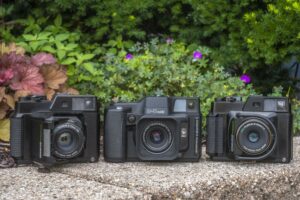
One year after that, a third model, the GS645S Professional kept the rigid body and added back the rangefinder from the first model, but offered an in between option of a 60mm f/4 lens which was still wider than the original 75mm lens, but a faster maximum aperture of f/4. All three cameras supplemented Fuji’s lineup of Professional roll film cameras and became popular options for those wanting medium format quality, while still retaining the economy of getting 16 or 32 exposures pre roll depending on which film was used.
In 1995, Fuji would update the lineup, replacing the manual focus GS models with a new GA series equipped with autofocus. The GA645 became the standard model with a 60mm f/4 lens, and the GA645W with a wider 45mm f/4 lens. Two years later, the GA models were revised, and released as the GA645i and GA645Wi with the two most notable changes being the addition of a second shutter release button for using the camera in landscape orientation, and support for Fuji’s new Barcode System which was a roll film equivalent to DX encoded 35mm in which a sensor inside the camera’s film compartment can automatically detect what type and speed film is loaded into the camera. In 1998, one final model in the GA series called the GA645Zi was released featuring a 55 – 90mm f/4.5 – 6.9 zoom lens.
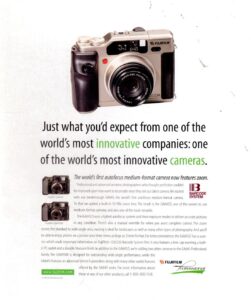
In my research for this article, I could not find any advertisements for the GA645Wi by itself, rather Fuji would often group multiple of their “Professional” medium format cameras together. In the ad to the left from February 1999, the GA645Wi is a footnote in the ad for the top of the line GA645Zi zoom lens camera.
I could not find any retail pricing for the camera as by the late 1990s, it wasn’t common for manufacturers to list MSRP in ads anymore and my access to photography review magazines from that era is sketchy at best. Using Google Books, I did find a couple retailers from that era selling the GA645Wi for around $1200.
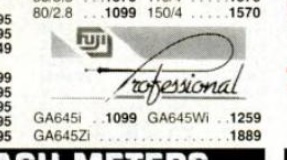
In an October 1999 ad for Honest Abe’s Focus Camera & Video in Brooklyn, NY from the back pages of Popular Photography, the GA645Wi has an advertised price of $1259. Back then, advertised retail prices were often several hundred dollars below MSRP, so it is likely that Fuji probably listed this camera somewhere in the range of $1600. Even at retail however, when adjusted for inflation, this compares to about $2225, which is certainly out of reach for the average amateur photographer, but within the realm of what a pro would pay.
With a production run of over 15 years, it is safe to say that Fuji’s GS645 and GA645 cameras were successful, although I’ve never found any indication of sales numbers. My best guess is that more than a few were sold, but less than many. By the start of the 21st century, Professional photographers were more and more leaning towards DSLRs like the Nikon D1. Although featuring sensors much smaller in size than a 4.5cm x 6cm piece of film, the gap in quality between digital and film was quickly narrowing, and within a few years into the new century, the demand for expensive roll film cameras was so low, Fuji discontinued the series.
Today, all of Fuji’s Professional roll film cameras appeal to collectors and shooters alike. The larger 6×9 and monster 6×17 panoramics fetch the highest prices, but the 645 models like the GA645Wi are valuable for their modern take on a classic formula. These cameras are essentially what a prewar Zeiss Nettar or postwar Japanese “semi” would be like if you mixed them together. I don’t often see these cameras for sale, but when they do, prices can escalate quickly, but if a camera with auto focus, auto exposure, auto film loading, a date back, and a full information viewfinder is something you’re interested in, buy one, as there aren’t too many alternatives.
My Thoughts
If you were new to shooting film and didn’t know where to start and were asking recommendations on what film formats you should consider, you might be interested in medium format for its larger images that can increase digital to make them more comparable to modern digital images, or you might be more into 35mm for its more compact size and that there simply are more options to choose from.
You really can’t go wrong with either format as there’s great cameras that use both kinds of film. If however, automation is a priority for you, perhaps because you’re not yet willing to dive into the world of manual exposure or manual focus, and want a camera that can do all of that for you, you’re likely going to turn to 35mm as there’s simply far more options.
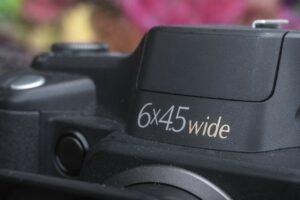
But just because 35mm offers more fully automatic cameras, doesn’t mean there aren’t any fully automatic medium format cameras. One such option is the Fujifilm GA645Wi Professional, a point and shoot medium format camera that shoots 4.5cm x 6cm (it is actually 41.5mm x 56mm) images on regular 120 (or 220) film. Don’t let the word “Professional” in the model name fool you, this is a camera that any novice can use as it does almost everything for you.
Where the Fuji does live up to its Professional moniker is in its build quality. Although using quite a bit of plastic in its construction, the camera is very well constructed and has a good deal of heft. The gray plastic body has a matte finish that is just grippy enough to not slip out of your hands like a shiny plastic, but without a feeling of dullness that a cheap plastic camera might. The whole camera weights a not-insignificant 880 grams which is in the realm of territory where having it dangle from a strap around your neck for elongated shooting sessions would cause fatigue.
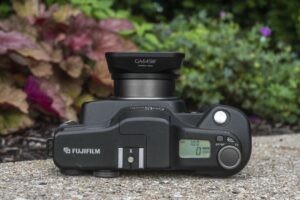
If the appeal of this camera is its fully automatic operation, then you probably wouldn’t expect to see a huge number of manual controls anywhere on the camera. The camera’s top plate is very clean, almost resembling an elongated point and shoot 35mm camera. The left side of the camera has a silkscreened Fujifilm logo and the flash hot shoe in the center. As this camera has an electronic leaf shutter, the flash is synced at all speeds. Although it is difficult to see from up top, to the right of the hot shoe is a pop-up flash which can also be used.
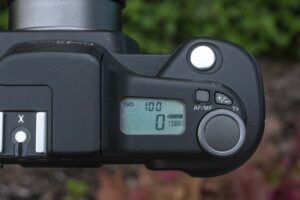
On the right, near the front edge of the camera is the top plate shutter release, a large gray control wheel for selecting the camera’s various modes, and in between, two small buttons that toggle between manual and automatic focus and exposure compensation. A large LCD takes up the rest of the space and shows the status of the camera’s settings, including remaining exposures, battery status, type of film loaded, film ISO, self-timer status, EV status, and both shutter speeds or f/stops depending on which exposure mode is selected.
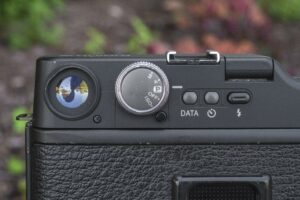
Around back are the rest of the camera’s controls. Next to the large round eyepiece for the viewfinder, is a mode dial, with options for manual exposure, aperture priority, programmed exposure, custom ISO film speed, and power off. To the bottom right of this dial is a lock button which must be pressed before making any changes to prevent accidental mode changes. To the right of this dial are three buttons for Data, Self-Timer, and Flash Mode. Each of these three buttons are used in conjunction with the control wheel on the top plate. The only other thing to see on the back of the camera is a film box reminder frame on the door.
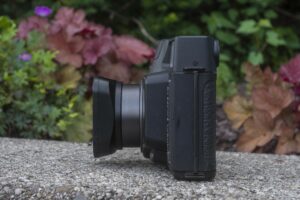
There’s very little to see on the sides of the camera other than metal strap loops on both sides, and on the right side is the film door release latch. Simply push it down until the door pops open. Another thing worth mentioning is that when powered on, the collapsible lens automatically extends to shooting position. With the camera off, it automatically retracts, making for an extremely slim camera.
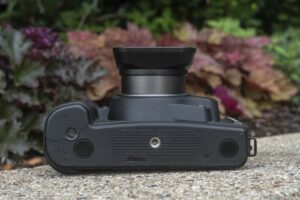
The bottom of the camera starts with the battery compartment cover on the left. Slide the cover off and insert two CR123A lithium batteries. It should probably come as no surprise that this camera is entirely electronic and will not work without power. In the middle is a metal 1/4″ tripod socket and on each side of the base are two round circles which are actually the bottom of the spool holders in the film compartment, which I’ll explain in the next section.
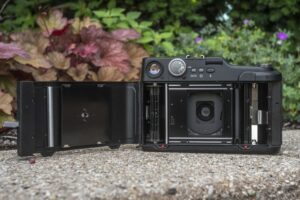
The left hinged film door swings open to reveal an interesting film compartment with equal parts of new and old technology. Type 120 roll film has been around since 1901 when it was first released in the No.1 Kodak Brownie, and despite nearly a century of progress, loading film into the Fuji is mostly the same. Film transports from left to right on removable 120 spools. As with every roll film camera made since that original Brownie, before loading in a new roll of film, you must first move an empty spool to the take up side on the right.
On the inside of the film door is a large metal pressure plate covered in divots to help reduce friction as film passes over it. In the center of a pressure plate is a switch for selecting between 120 and 220 film. Getting this setting correct for the type of film you are using as the pressure plate needs to be in a different position for each film.
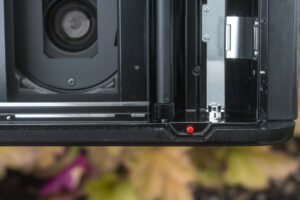
When it is time to install film, inserting a spool is a bit different than it used to be as there are no knobs to pull on to help you attach the film leader to the spool. Two red buttons on either side of the film compartment must be pressed in order to release the bottom spool holders. Pressing these in allow you to easily move the old spool to the take up side and insert in a fresh roll of film. Once each side is loaded, press in on two round discs that are sticking out on the bottom of the camera.
With the spools in place, stretch the paper leader across the film gate and insert it into the slot of the empty take up spool. Whenever the film door is open, the control dial on top of the camera acts as a film advance knob, allowing you to rotate the take up spool to help secure the paper leader to the spool. Continue advancing the film until the Start mark on the backing paper is aligned with the red button on the left side. You do not need to get it perfectly lined up, but try to get it as close as possible.
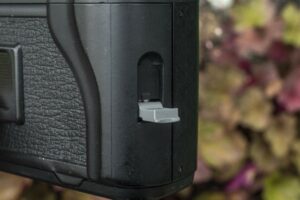
Once you are sure the paper leader is securely attached to the take up spool and the Start mark is aligned with the left red button, close the door and make sure the door release is secured in its up position. If the camera is already powered on, closing the door will automatically advance it to the first exposure. If the camera is not on, this will happen automatically the next time it is powered on.
A neat feature of the Fujifilm GA645Wi Professional is that it supports something called the Barcode system which is sort of a DX encoding for roll film. Around 1998, Fuji created this system in which they printed a standardized barcode on the paper leader which the camera can read to determine the speed. All of their roll film cameras at the time supported it as we as a couple Hasselblad and Contax roll film cameras. If you load film into the camera with these codes, the camera will automatically detect the ISO, if not, you’ll need to set it yourself. The sensor for this system is the little slit to the right of the left metal roller.
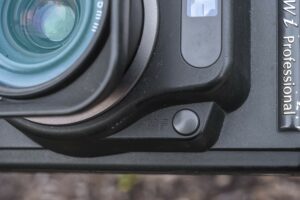
With film loaded, the camera powered on, and your chosen exposure mode selected, there’s little else to do before you can make exposures. The only remaining control on the camera is a single MF button which is used when the camera is in manual focus mode. Holding this button down while rotating the command dial manually focuses the lens. While this feature was likely a requirement to include the word “Professional” in the name, this style of push button focus is not appealing to most, and I would suspect was rarely used. If you’re not interested in manual focusing and autofocus camera, the MF button can also be used as a focus lock with autofocus on.
The Fujifilm GA645Wi Professional has a long list of features, but the one part of the camera that most closely resembles a point and shoot is the viewfinder. A very bright straight through optical viewfinder with bright frame lines with automatic parallax correction, the viewfinder is very easy to compose your image. A red 7-segment LED display at the bottom shows you things like selected f/stop, shutter speed, focus distance, and whether flash is enabled. Lastly, a bright plus sign in the middle helps you orient the center of your image.
The gallery above shows three shots through the viewfinder with the camera at various positions away from an object. Notice that in the 0.7m image on the right, the yellow frame lines are reduced in size to account for parallax error. This happens automatically, and is really cool to see the lines moving as the distance changes. Remember, the lens on this camera does not zoom, I moved myself and the camera closer to the self with each shot. In the bottom right corner, you can see the approximate focus distance that the camera has detected. The focusing system is not infinite, but using the wide depth of field afforded by the wide angle lens, uses zone focus groups to achieve sharp images.
Although this is going to be good enough for most shooting situations, when the camera is in manual focus mode, you get to choose the distance. Since there is no rangefinder and this isn’t a TTL viewfinder, your only indication of what the lens is focused to is via the red LED display in the bottom right corner.
The Fujifilm GA645Wi Professional is a medium format camera with a lens that promises to deliver images unlike those from most cameras of its era, while still being extremely easy to use, even for the beginner. With the exception of maybe loading film, you could probably give this camera to someone who has never seen one before, and they would be up and running making images with little effort.
An easy to use fully automatic camera with a wide angle lens is an exciting proposition, but what is it like to shoot? Keep reading…
My Results
I would shoot two rolls of film in the Fuji in rather quick succession. The first was near the end of Winter 2021 at Brookfield Zoo near Chicago, and for that I used a ~5 year expired roll of Kodak Portra 160NC. The second was a roll of fresh Kodak Ektar 100 later that spring at Turkey Run State Park near Marshall, Indiana. Taking full advantage of the camera’s many auto everything modes, I approached both rolls as if I had a point and shoot camera and let the camera make all its decisions for me.
Both rolls from the Fuji came out quite nice. The Portra 160NC film was understandably neutral as the name suggests, but even the Ektar was a bit muted too. I don’t know if that has anything to do with the camera, the lighting on the days I shot it, or how I developed it, but nevertheless, I’d say the images were nice.
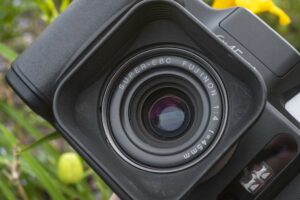
As you might imagine, the 7-element 45mm f/4 Super-EBC Fujinon did a good job too. Sharpness was good across the frame without significant softness near the corners and only the slightest hint of vignetting near the corners in scenes where the sky is visible. The presence of vignetting on a 7-element lens was a bit surprising, although I didn’t think it detracted from the image quality at all.
Shooting what is effectively a 28mm lens for a normal 35mm camera, but on medium format is unlike any other I’ve had before. My experience with roll film cameras has almost exclusively been with fixed lenses in the 75mm – 105mm range, so to be able to fit as much in the frame as you can as with the Fujifilm GA645Wi Professional is truly remarkable.
I did however notice that like most fully automatic point and shoot cameras, the autofocus system didn’t nail focus on every shot. This is concerning not only for a camera billed as a “Professional” camera, but also that the depth of field on the wide angle Fujinon should be huge enough that even a basic auto focus system shouldn’t have struggled. If you look at a couple of the hiking pics from the state park, what should have been easy infinity shots, all came out soft.
The camera also struggled with the mirror selfie pic, even though the camera should have easily detected me in the center of the image. Without any indication in the viewfinder that I had focus correct, I had no idea this image was out of focus until I saw it. I actually took this picture three times and all three times it was out of focus, suggesting that perhaps whatever technology the camera uses, can’t handle reflections. And yes, I could have tried this image in manual focus mode, but I felt as though I should test the camera’s technology, rather than my ability to manually select focus with an electronic dial. Besides, even if I had, I would have had the same problem judging distance as you can’t “see focus” even in manual mode.
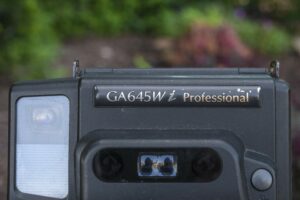
I will concede though that the mirror selfie and the trail hiking pictures were all the images with the poorest lighting. Perhaps low light situations was too much to ask of the camera.
In ideal lighting, the Fuji performed well, giving me nice looking and sharp wide angle photos. The increased size of the medium format images gives the final images increased detail, closer to what you would expect from a digital camera, while still having the characteristic of film.
I generally liked the operation of the camera. It is strange to handle such a modern feeling, plastic bodied, fully automatic roll film camera. The location of the controls was comfortable and the size of the camera gave me confidence in holding it, unlike smaller compacts with slick plastic bodies that can sometimes slip out of your hands.
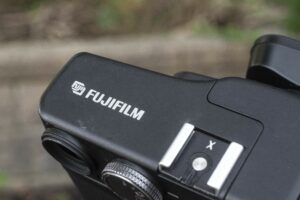
Setting aside imperfect autofocus performance and a little more vignetting than I would have expected from a 7-element lens, I still struggle with my final verdict of the camera. I also don’t think I understand who the target market for this camera was. I was fresh out of high school when this camera first went on sale, so I have no idea what the pros might have wanted in the years this camera was available new. The inclusion of having full control over shutter speeds and f/stops, the date back and film barcode features, plus the ability to manually focus the camera were all good decisions by Fuji and are likely the basis for where the “Professional” label came from. But I just don’t see a huge market for an inflation adjusted price of $2200 for a medium format plastic point and shoot camera.
I certainly didn’t dislike the camera, but after shooting the first two rolls, I couldn’t shake the feeling of being underwhelmed with it. Yes, the specs look great on paper, and yes, the actual use of the camera was fun, and yes, it made good images, but I think that this is a good example of “less is more”.
I am sure after posting this article, people will point out how popular Fuji’s medium format cameras were for portrait and wedding photographers. These were never intended to be walkabout “zoo cameras” like how I used this one. Perhaps I am fundamentally missing something that was critical for the pros. Still, for the price, I just don’t think I would have ever bought one, and from my limited research, very few of you ever did either.
Overall, I did like the Fujifilm GA645Wi Professional. The wide angle lens was the best feature for me. I loved being able to fit so much in my images. The camera is easy to use, even for the first timer, has a good lens, and it allows for full control over exposure, which is more than many other cameras can do. I’ve never shot any other camera like this before, and I probably won’t again as shortly after my two test rolls, it went to the post office, on its way back to its owner.
Related Posts You Might Enjoy
External Links
http://camera-wiki.org/wiki/Fujifilm_GA645
https://www.antiquecameras.net/fuji645cameras.html
https://mrleica.com/fuji-ga645-review/
https://shootitwithfilm.com/fuji-ga645-camera-review/
https://www.120folder.com/fuji_ga645wi.htm

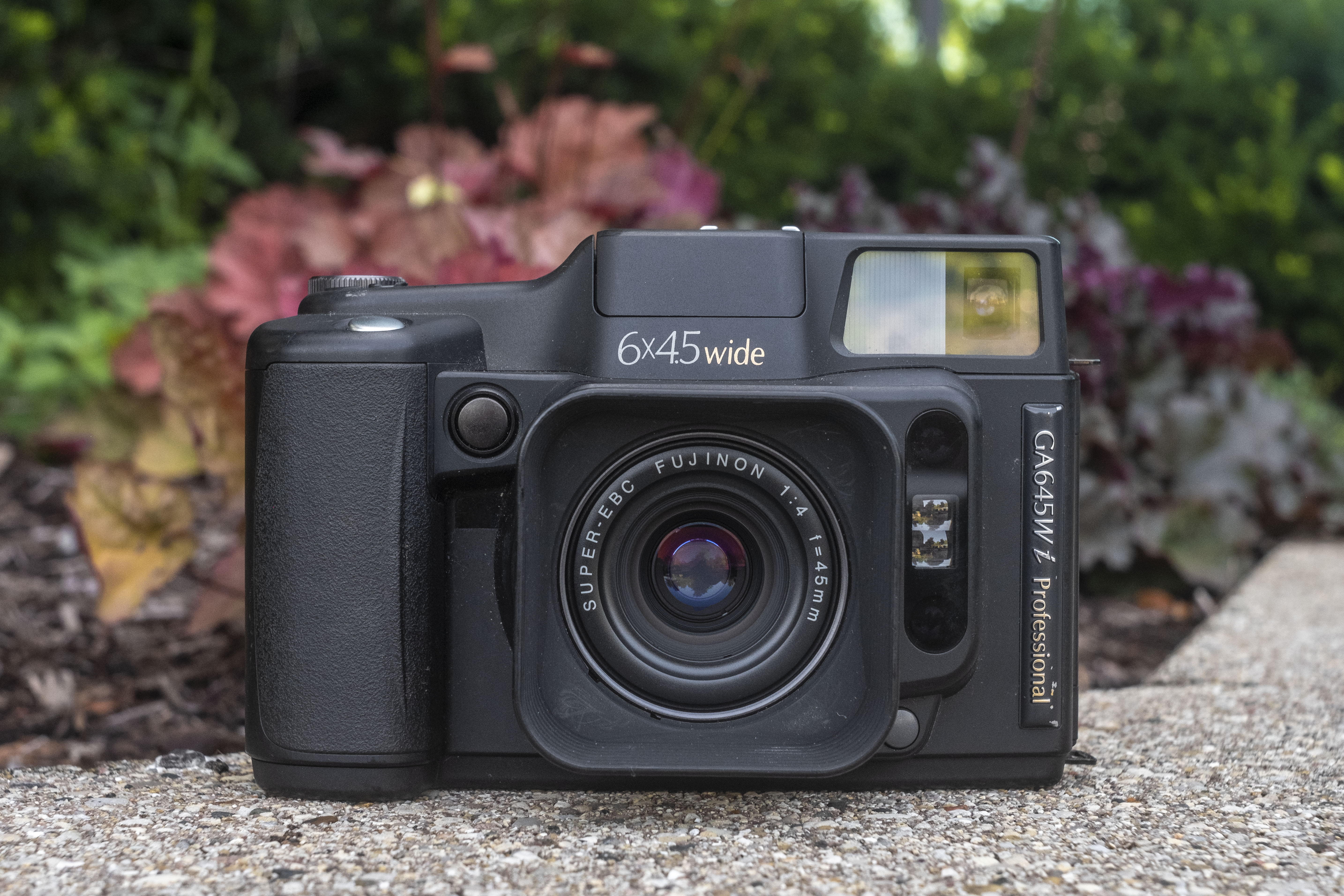
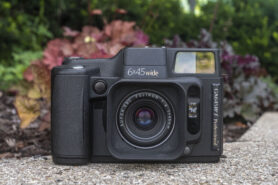
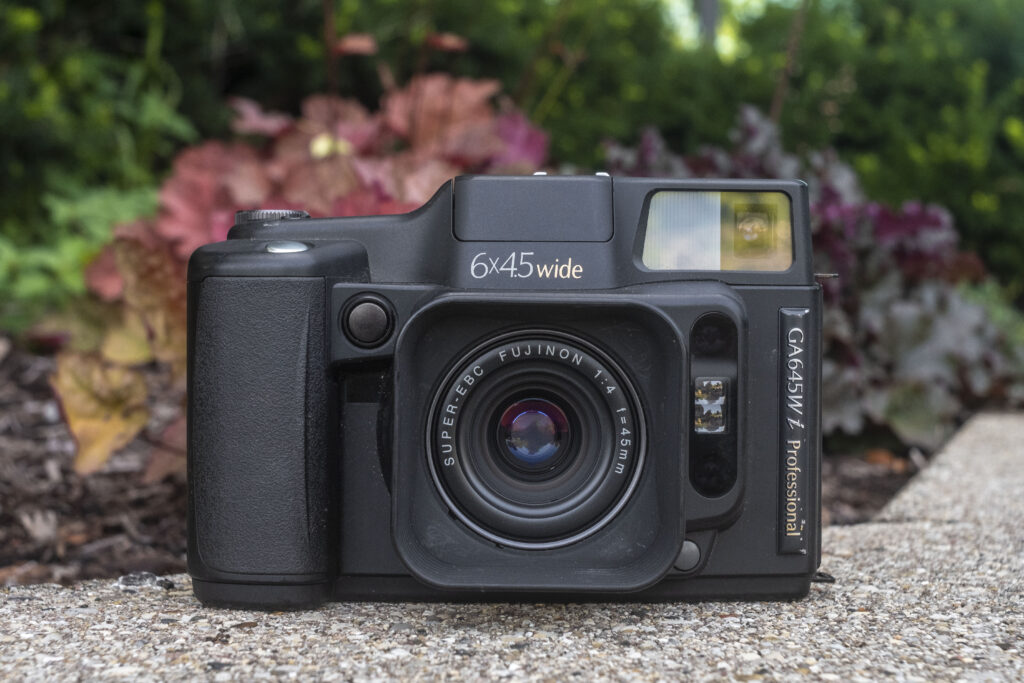
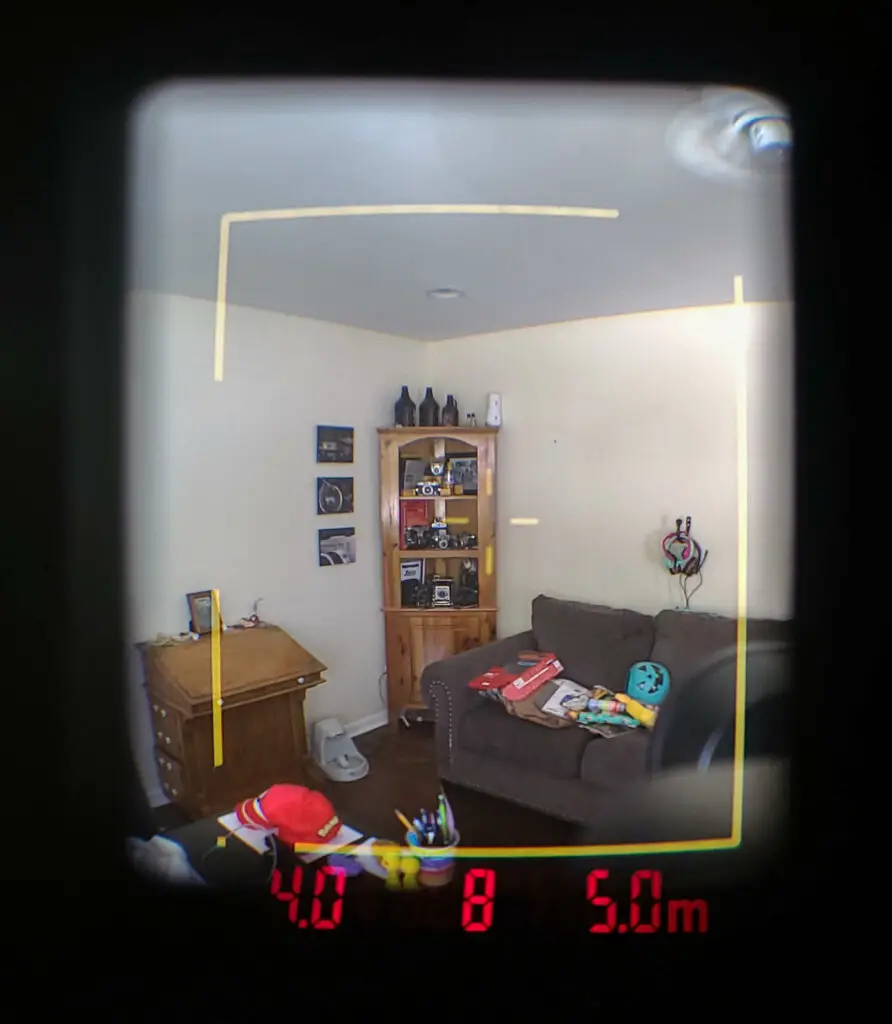

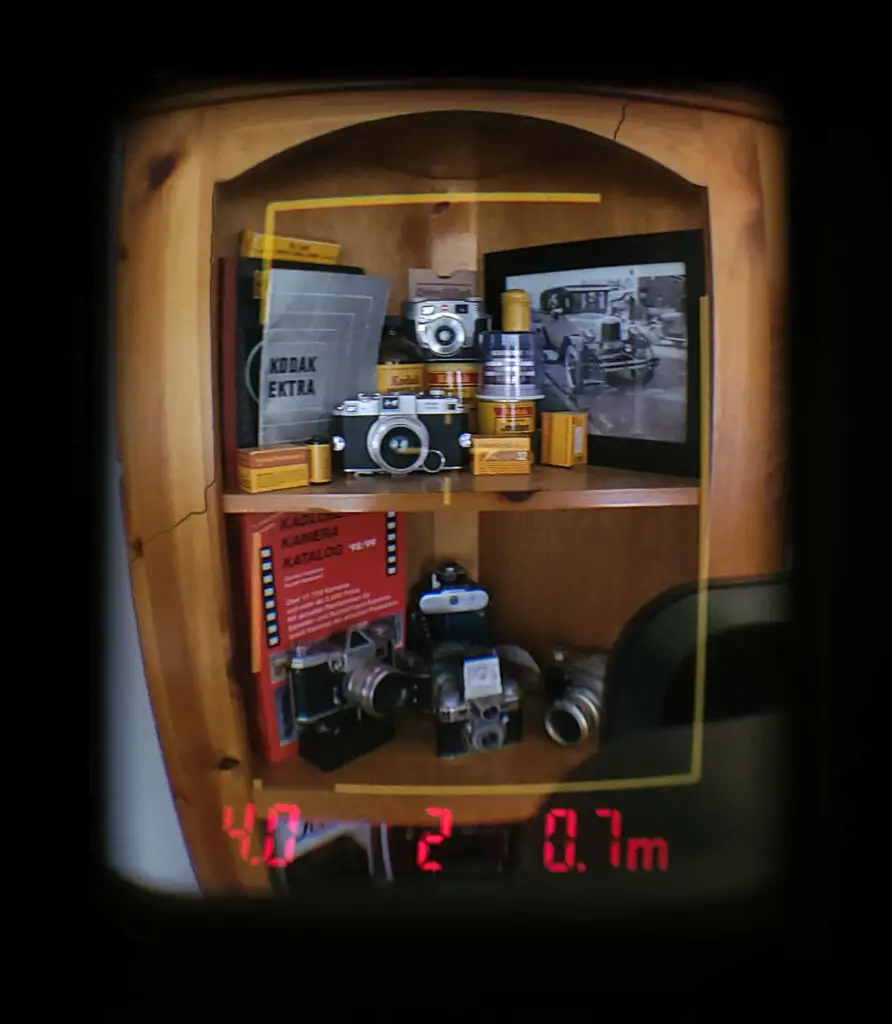























Your “market analysis” of these Fujis makes sense. I had a GS645 some years ago – the original model – and sold it after just a couple of shoots. Word is, there are few if any US repair houses that will service the later AE Fujis – mostly due to a lack of parts. The basic folders, guys like you and I can usually CLA successfully. But the model you review here? Nope. That’s a sale-breaker for this old man.
I feel the same way about the Xpan, the Contax G series cameras, those Nikon 35 and 28Tis, and pretty much all those high end “prestige” cameras from the 90s and early 00s. They are intriguing cameras that I have no doubt can make good images, but once they die, and they will, there won’t be anyone who can repair them!